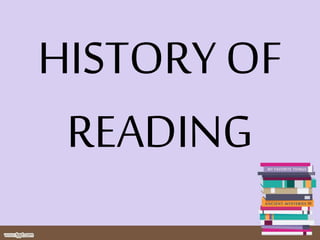Report
Share

Recommended
More Related Content
What's hot
What's hot (20)
Preparation and evaluation of instruction materials

Preparation and evaluation of instruction materials
Similar to Reading history
Similar to Reading history (15)
Developmental reading - preview on reading and history of reading

Developmental reading - preview on reading and history of reading
HISTORY OF READING.pdf: AN INTRODUCTION TO READING AND WRITING

HISTORY OF READING.pdf: AN INTRODUCTION TO READING AND WRITING
Book Review: Archaeology a very short introduction by Paul Bahn

Book Review: Archaeology a very short introduction by Paul Bahn
More from Draizelle Sexon
More from Draizelle Sexon (20)
financial management and marketing for the 21st century

financial management and marketing for the 21st century
Reading history
- 2. “Reading is to the mind what exercise is to the body.” - Richard Sleete
- 3. “A man without books is as a body without a soul.” - Cicero
- 4. “The greatest gift is a passion for reading. It is cheap, it consoles, it excites, it gives you knowledge of the world and experience of a wide kind. It is a moral illumination.” - Elizabeth Hardwick
- 5. Let us look at the distant past…
- 6. • According to paleontologists who study fossils and other evidence of life on earth, as the first man lived in communities, he was a social being who communicated with his kind. • In the beginning, however, he employed grunts and body language using gestures and postures to convey his ideas and needs to others.
- 7. • Slowly, he developed oral language which enabled him to express more clearly the messages he wanted to convey. • In time, various circumstances such as the need to communicate to others who are distant in place caused man to devise symbols corresponding to his oral messages.
- 8. • The Old Stone Age rock painting and in the cuneiform are evidence of the earliest human act of picture-writing and reading.
- 9. • Egyptian civilization along the Nile River carved their pictorial symbols known as hieroglyphics on the stone wall of temples and tombs. • Egyptians also invented Paper derived from the Papyrus plant.
- 10. • But the greatest contribution to the progress of ancient civilization came from the Phoenicians who adopted and spread the use of letter-symbols of the alphabet. • Due to its simplicity, it was developed by other people such as by the Greeks and the Romans.
- 11. Trace back the history of reading and communication…
- 12. How is reading done by the 21st century learners?
- 13. Thank you!
